Build an eBay Business Part 7
Selling for Others
As an experienced seller on eBay, you’re probably always
bombarded with questions from friends, relatives, and cocktail
party acquaintances about how they, too, can join in on
your eBay success. One option is to spend hours with them,
teaching them the ins and outs of your business. Alternatively,
you could buy them a copy of this book. Your best option in
terms of continuing to be a profitable eBay business is to
offer to sell their items on eBay for them. Selling for others on
eBay as a business, or consignment selling, can be as simple
as selling items for friends out of your home, or it can be as
involved as opening a brick-and-mortar storefront location.
You can wing it, using the same tools you do for your current
eBay business, or you can add software, join affiliations, and
open a franchise. This chapter explores the avenues you can
take to add to your bottom line using this selling opportunity.
Become an eBay Trading Assistant
eBay provides a program whereby sellers who meet minimum qualifications
and express an interest to sell items for others can list their profile in a Trading
Assistant Directory. eBay users can search the list and find trading assistants
in their locale. Although there’s nothing to stop you from selling on eBay for
others without becoming an eBay trading assistant (or TA), there’s really no good
reason not to become one. As with other eBay-structured programs, the eBay
marketing wizards circle around you, help you generate sales, and expand the
symbiotic relationship that benefits eBay along with your business.
Apply to Be a Trading Assistant
You must meet certain qualifications to be accepted as an eBay trading assistant.
These qualifications ensure that you have demonstrated maintaining a certain
level of eBay values and experience:
• Recent sales experience. You must have sold at least ten items in the past three
months and maintain that rate of sales of ten items each three-month period.
• eBay buying or selling track record. Your feedback score must be at least 50.
• Good customer relations. Your feedback rating must be 100 percent, maintaining at
least 98 percent positive comments.
• Financial responsibility. Your eBay account must be in good standing.
• Maintain eBay values. You must agree and abide by the Trading Assistant Style
Guide, which provides detailed instructions on using the eBay trading assistant logos,
the required disclaimer on any TA materials you produce, authorized taglines, and
proper identification of yourself, that is, “Trading Assistant on eBay.”
To apply to become a TA:
1. Click Site Map on the eBay header.
2. Under Selling Resources, click Trading Assistant Program.
3. On the eBay Trading Assistant Program page, click
Trading Assistant Requirements And Sign-Up on the
left sidebar.
4. On the Sign Up page, click Trading Assistant Terms
And Conditions on the left sidebar to review the terms
of the program.
5. Back on the Sign Up page, click Sign Up on the left sidebar.
If you are lacking in qualifications, eBay will quickly let you know, as shown in Figure 7-1.
If you do qualify, you will continue to set up the profile page that displays in the Trading
Assistant Directory and advertises your services.
At first glance, most people seem to think eBay trading assistants are a highly select group of PowerSellers who have warehouses, super auction-management programs, and other top-tier business characteristics. Although some do match those qualifications, the truth of the matter is that virtually any eBay seller with moderate feedback can offer to sell for others. How each trading assistant does it, however, is another matter.
Trading assistants differ in:
• What they charge
• What items they will sell (in addition to standard eBay guidelines)
• What drop-off/pick-up conditions they offer
• How they want to be contacted
• How they market themselves eBay sellers become trading assistants for a variety of reasons:
• Friends, relatives, and neighbors ask them to sell items for them
• They’ve run out of inventory and need to look for other sources
• They enjoy the mechanics of selling but don’t have the time or interest to search for items to sell
• They want to add another sales channel to their overall eBay business plan If you want to explore this rapidly growing aspect of eBay, give it a shot. Anyone with an eBay seller’s account can sell an item for someone else, but if you want to be listed in the Trading Assistant Directory so that buyers can easily find you and have eBay provide other marketing assistance, become an eBay trading assistant (TA). (See “Apply to Be a Trading Assistant” later in the chapter.) If you have a physical storefront and want to provide walkin services, become a registered eBay drop-off location (see “Open a Drop-Off Store” later in the chapter).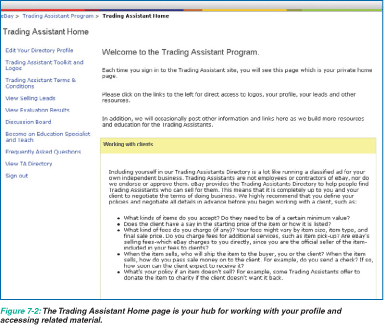
when deciding to choose you from a crowd of other TAs, it’s imperative that you present your services effectively. To simplify the process, eBay collects most of the information by having you select options from prepared lists (see “Apply Trading Assistant Profile Strategies” for more information on setting up
your profile).
1. Continue from the previous section when first setting up a TA account (see “Apply to Be a Trading Assistant”).
–Or–
Log in to your TA account.
In either case, the Trading Assistant Home page displays, as shown in Figure 7-2.
2. Click Edit Your Directory Profile on the sidebar (you may see Create Your Directory
Profile instead). Complete the first page of the form with your contact information. Click
Continue when finished.
3. On the Your Profile: Services page, select the primary and secondary categories of items
you will sell, along with subcategories of items, as shown in Figure 7-3.
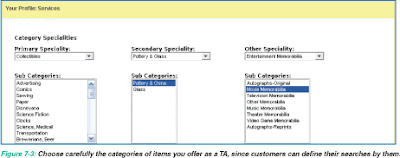
4. Identify the drop-off hours you will be available, if offered, and the pick-up range you
will travel to collect items, if offered.
5. Identify your trading specialties, for example, consumer/household goods, charitable
donations, and auto parts and accessories. In the Languages Spoken area, indicate
the languages you speak.
6. Type a description of your services, your fee arrangement, and your terms and
conditions. Click Continue when finished.
7. On the final page of the profile, preview your selections and click Save when
completed. Your profile will be added to the Trading Assistant Directory and will appear
to potential clients, similar to the profile shown in Figure 7-4.
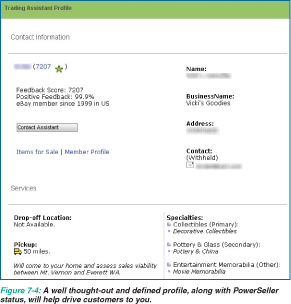
Apply Trading Assistant Profile Strategies
You can probably complete a TA profile form in less than five minutes, but
as with most things, you’ll get out of it what you put into it. There are many
subtleties embedded in the selections you make and in the text you provide.
Consider the following points when setting up or changing your profile:
• Numbers count when it comes to your eBay feedback score. Boost your score (and
the attention you garner in search results) by buying or selling several cheap items
(a recent change to eBay policy provides positive feedback credit for each positive
comment, regardless if it’s from the same buyer or seller that submits one for you).
• Be careful when selling from your home. Divulging personal details, such as your
house number in the Address field, is like offering potential malfeasants a flashing sign
that says, “Large inventory of valuable items for grabs—and I’ll provide a map for you!”
• Offer a drop-off service judiciously to avoid problems at your home. For much of the
same reasoning as the previous point, you should prescreen prospective clients at a
neutral location or over the phone before inviting them to your home. Of course, if you
have a place of business, such as a drop-off store, whether or not you are a registered
eBay drop-off location (see “Open a Drop-Off Store” later in the chapter), you’ll want to
encourage across-the-counter traffic.
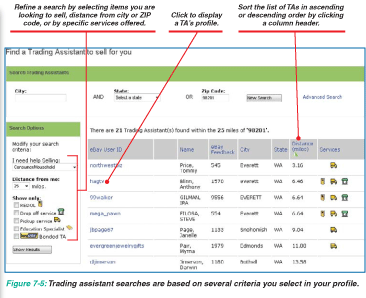
• Toot your horn in the Service Description area. Much of the information in a TA
profile is limited to choices provided by eBay. The Service Description area is the
one place you have to distinguish your service from others. Emphasize experience,
due diligence, and extra services you offer (research and estimates of value, on-site
consignment sales, and other value-added opportunities for your clients).
• Simplify your fee structure to make it easy for clients to understand. Try and
structure your costs in as streamlined a manner as possible to avoid listing a string
of seemingly endless fees your clients need to pay. It might all work out the same
mathematically, but first impressions count. For example:
• Charge a modest flat fee upon receipt of an item to cover your research and listing
costs in case the item doesn’t sell. Average item-receipt fees are in the $15 to $20
range.
• Add a commission percentage based on the final value fee. A
decreasing commission percentage based on a higher final value fee
is fair but adds more complexity to the fee structure. By streamlining
your fees, you make it easier for the consignor to make a decision.
• Charge the buyer actual shipping costs plus a small amount to cover
your time. This part of the transaction is between you and the buyer,
and is transparent to the consignor.
• Absorb eBay fees into your commission rate so you don’t have to list
another set of fees to the client.
• Keep your terms and conditions brief. State a few relevant points to
protect yourself against 99 percent of potential problems. For example,
include a statement that you have the right to refuse any item, and
declare the limits to your responsibility (you’re not liable for shipping
problems). Don’t try to cover every possible scenario or you’ll turn off
potential clients with your overzealous legalese.
Market Your Trading Assistant Business
eBay provides a tremendous amount of marketing materials, information, and
education to assist TAs. The central repository for links to all things TA is the
Trading Assistant Home page (only available for current TAs who have logged in).
1. Click Site Map on the eBay header.
2. Under Selling Resources, click Trading Assistant Program.
3. On the Trading Assistant Program page, click Trading Assistant Log-In on the left
sidebar. Sign in with your normal eBay User ID and password.
4. On the Trading Assistant Home page, on the left sidebar, view a list of topics covering
various aspects of being a TA. The following sections describe some of these
resources in more detail.
USING THE TRADING ASSISTANT TOOLKIT
eBay has assembled a collection of marketing information, templates, and other examples of marketing deliverables and organized them in a convenient “toolkit” that you can use to find what you want.
1. From the Trading Assistant Home page, click Trading Assistant Toolkit And Logos.
2. On the Toolkit page, shown in Figure 7-7, review the list of resources that describe best practices, tools, and ancillary information. Click the links to the information you want. Many documents are in PDF format so you can save them to your local computer system and start building your own business library.
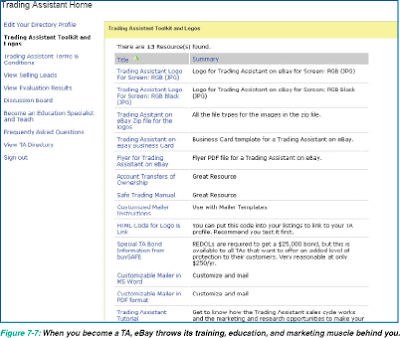

eBay provides information in a five-step process to help you develop a selling strategy, find and retain clients, and sell items.
1. From the Trading Assistant Home page for current TAs, click Trading Assistant Toolkit And Logos.
2. From the list of TA resources (see Figure 7-7), click Trading Assistant Tutorial. A PDF document will open (assuming you have Adobe Reader, Adobe Acrobat, or a third-party PDF
viewer program).
3. Click a step on the TA Business Cycle graphic, as shown in Figure 7-8.
The five steps are as follows:
1. Plan TA Strategy provides information on foundation business practices, such as developing business and marketing plans (see Chapter 1), tracking sales and accounting data, and branding and integrating your TA business with other eBay and off-eBay selling channels.
2. Generate Client Leads helps you develop traditional marketing materials and techniques, such as flyers, press releases, and phoning, as well as Internet-age avenues, such as e-mail, using keywords effectively, and enhancing your eBay listings, eBay Store, and About Me and My World pages. Chapter 10 describes several of these marketing and promotional tools.
3. Qualify And Close Leads offers pointers to quickly assess prospective clients and determine if they are a good match for you. Sales techniques to help you expand your relationship with clients and to finalize transactions are described. Also covered are ways to protect your business from items that might be counterfeit or copyright-protected, as well as setting up contracts.
4. Sell Client Product reviews information on running a conventional eBay business. Best practices on finding the best selling categories, listing techniques, shipping information, and managing the business are also covered.
5. Retain Clients provides tips on how to keep your clients returning after you’ve
completed a sale for them.
Add the Trading Assistant Logo to Your Listings
It’s a snap to add Hypertext Markup Language (HTML) code to your listings descriptions, advertising to buyers and bidders that you are a TA. eBay will display the TA logo as well as a link to your TA directory profile.
1. From the Trading Assistant Home page for current TAs, click Trading Assistant
Toolkit And Logos.
2. From the list of TA resources, click HTML Code For Logo And Link. A TXT document
will open.
3. Copy and paste the code at the end of your item description in your selling form.
4. Substitute your eBay User ID for XXXX.
5. Preview the listing to ensure the logo and link appear correctly and that clicking the link
displays your TA profile. Submit the listing. The link to your profile and eBay’s official TA
logo are displayed in your listing.
TRADING ASSISTANT SERVICES
eBay conducted a survey a few years ago to gauge what
marketing techniques TAs used to attract customers and
how customers actually learned about the TA marketing
efforts.
FOCUS YOUR MARKETING EFFORTS
Thirty-one percent of TAs use other sources of marketing besides their TA profile page to make potential clients aware of their services.
The top marketing techniques used include:
• Flyers and other offline marketing materials (54 percent)
• E-mails to friends and family (42 percent)
• TA logo in listings (39 percent)
• Newspapers (28 percent)
• Online advertising and keywords (18 percent)
• Social networks (9 percent)
ENABLE CLIENTS TO FIND YOU
The most effective way to attract clients is to provide superior service to existing clients and let them market your business.
The top means of finding a TA are:
• Word of mouth (66 percent)
• Flyers and other offline marketing materials (27 percent)
• TA logo in listings (19 percent)
• E-mails from friends and family (19 percent)
• Newspapers (17 percent)
• Online advertising and keywords (6 percent)
As with all aspects of eBay, there is a plethora of support available from other members who operate TA businesses.
JOIN A TA GROUP
eBay groups are forums for members who share a common interest to exchange information and experiences. The Trading Assistant groups cover the business of selling for others based on several interest areas, such as geographic location, types of items sold, and experience level.
To access the TA groups:
1. Point to Community on the eBay header, and click Groups from the drop-down menu.
2. On the eBay Groups page, under Groups, click Seller Groups.
3. On the Seller Groups page, scroll down to the Trading Assistants area. The first three of the several TA groups are shown. Click More In Trading Assistant to access the full list of groups and click any that interest you. The group’s home page, as shown in Figure 7-9, will tell you more about the focus of its membership.
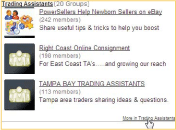
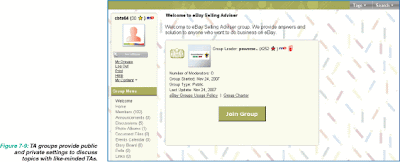 4. Click Join Group to join a particular group and have access to the group’s activities and its members. If you haven’t already, you will need to sign in. If the group is private, you will also need to request membership to the group by sending a message to the group leader and providing a reason why you want to join the group. Once accepted to a group, you will receive an e-mail confirming your acceptance and providing links for other group-related announcements, as shown in Figure 7-10.
4. Click Join Group to join a particular group and have access to the group’s activities and its members. If you haven’t already, you will need to sign in. If the group is private, you will also need to request membership to the group by sending a message to the group leader and providing a reason why you want to join the group. Once accepted to a group, you will receive an e-mail confirming your acceptance and providing links for other group-related announcements, as shown in Figure 7-10. REVIEW THE TA DISCUSSION BOARD
A great place to review comments and questions by both TAs and eBay members who are interested in using TA services is the Trading Assistant Discussion Board.
1. From the Trading Assistant Home page, click Discussion Board on the left sidebar. Click to provide direct access to the Trading Assistant discussion board.
–Or–
Point to Community on the eBay header, and click Workshops/Discussion Forums. Under Community Help Boards, click Trading Assistant.
2. On the Trading Assistant page, scroll through the list of discussions, as shown in Figure 7-11, and click the topic that interests you. Sign in if you want to submit a topic.
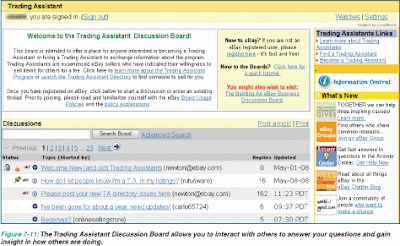 ATTEND OR VIEW TA-RELATED WORKSHOPS
ATTEND OR VIEW TA-RELATED WORKSHOPS eBay workshops allow members to interact online in real time with moderators who present information on various topics. If you cannot make the scheduled workshop, you can view past workshops from the workshop archives.
1. Point to Community on the eBay header, and click Workshops/Discussion Forums.
2. On the Discussion Boards page, under Workshops, click Calendar to review the current calendar for any upcoming or recent workshops that interest you as a TA. Click the link to learn more about the workshop or to review past comments.
3. To see workshops from past months in the current year, as well as the prior year, click the applicable archive on the left sidebar, and click each month to see a list of the workshops held.
Open a Drop-Off Store
A drop-off store is a physical storefront where customers bring you items they want to have sold on eBay. A drop-off store operates much like a trading assistant who offers drop-off hours at a personal residence, except a drop-off store is in a business or commercial setting and staffed during normal business hours for drop-in customers. While it may seem like an extension of your current trading assistant business, a drop-off store brings you fully into the fold of retail businesses and their associated concerns. As a true brick-and-mortar business, a drop-off store requires a serious look at a number of considerations that go well beyond the plans, models, and experiences you’ve had with eBay-only selling. However, eBay doesn’t leave you completely on your own. You can aspire to become an eBay-sanctioned Registered eBay Drop Off Location (REDOL), a drop-offstore designation for bonded trading assistants with a demonstrated sales record.
Understand Drop-Off Store Considerations
If you are contemplating opening a drop-off store, you need to consider all aspects of running a retail business in addition to those that are more closely related to running an eBay business.
A few of the more salient issues you will need to think about include:
• Location, location, location is critical, perhaps not in the classic sense of real estate investment value, but in the site’s ability to attract and retain a customer base. Does its size meet your needs? Is there adequate parking? Can customers easily transport larger items from their parked location? Will the square footage of the building provide enough room to store inventory and set up processing centers to handle a steady and voluminous stream of merchandise?
• Zoning, business restrictions, and other governmental influences come into play. Is the site properly zoned for the business classification under which you’ll be licensed? Some municipalities place restrictions on businesses considered “secondhand stores” by placing holding periods on items you sell and requiring documentation of sales. Are you willing to put a public face on your eBay business and incur the exposure, and perhaps scrutiny, that your eBay User ID has shielded you from?
• Build your own store or work with a franchise. A few national franchises (see the “Starting a Drop-Off Store Franchise” QuickFacts) can deliver everything you need to get you started and help you build the business. Do you have the experience, time, and entrepreneurial spirit to bring all the facets of the business together and act as your own general contractor, or do you need to spend the upfront and commission costs for an all-in-one solution? One approach is to diversify your business with a few different product lines to spread the risk. For example, Figure 7-12 illustrates how one business combines espresso/ice cream shop retail sales with consignment transactions, both onsite and online.
A company called AuctionDrop (www.auctiondrop.com) brought an interesting twist to the franchise and dropoff- store concept. In partnership with The UPS Store franchise, AuctionDrop provided a service that allowed an owner to sell an item on eBay by simply dropping off the item at any UPS Store. The UPS Store packaged the item and sent it to AuctionDrop, which then opened the package, wrote a description, took pictures, and listed the item on eBay. Due to an extensive list of item requirements, including weight, age of the item, and minimum value, as well as low margins, the concept and partnership was dissolved in 2007. Sometimes a better mousetrap is not a profitable mousetrap.
Start and Maintain a Registered eBay Drop-Off Location
A Registered eBay Drop-Off Location (REDOL) is to trading assistants as PowerSellers are to other eBay sellers—they represent the top-tier businesses that maintain drop-off locations. The registered designation provides two major benefits:
• Your profile is highlighted with the REDOL logo when potential clients search the
Trading Assistant Directory for TAs with drop-off locations.
• The REDOL logo can be used on the physical storefront (certain restrictions apply, as
noted next).
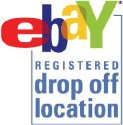
To qualify to become a REDOL, you must first be a TA and adhere to the requirements to be TA (see “Apply to Be a Trading Assistant” earlier in the
chapter). Additionally, you will need to abide by a separate user agreement
specific to REDOLs (see Note). Some of the requirements include:
• Minimum general liability insurance of $1,000,000
• A $25,000 bond to ensure seller payments (see the “Becoming Bonded” QuickFacts)
• Adherence to the REDOL Style Guide (access the guide from a link in the REDOL
user agreement)
• Maintaining entry requirements and being subject to eBay scrutiny through review by
customer-satisfaction surveys.
To apply to be a REDOL:
1. From the Trading Assistant Program page (Site Map | Trading Assistant Program), click Trading Assistant Requirement And Sign-Up on the left sidebar.
2. On the next Trading Assistant Program page, click Registered eBay Drop-Off Location Terms And Conditions on the left sidebar.
3. Review the terms of the user agreement, and click the embedded link to also review the style guide.
4. When you are ready to apply, log in to your TA account, and click Edit Your Directory Profile on the sidebar of the Trading Assistant Home page.
5. Click Change Status at the top of any of the directory pages.



0 comments:
Rašyti komentarą